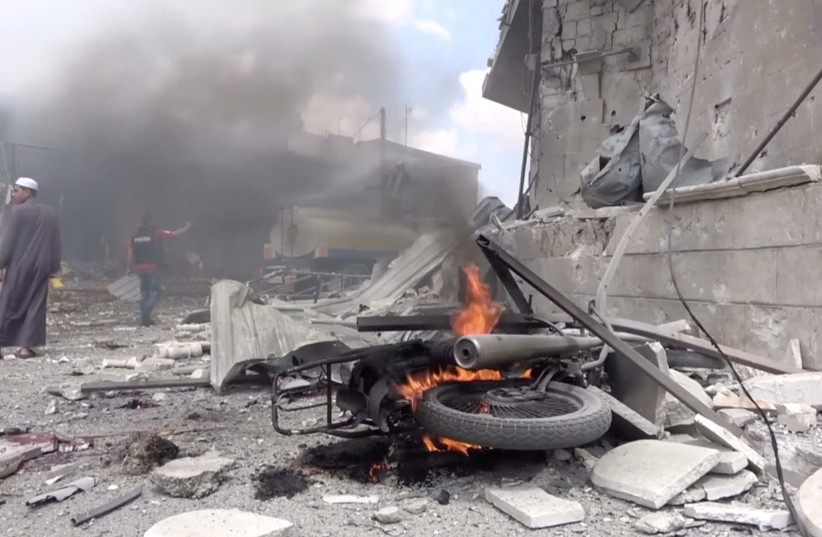The strikes come as the Trump administration is wrapping up its era.
By SETH J. FRANTZMAN

Large airstrikes in Syria overnight Tuesday shook the ground in the border city of Albukamal and the city of Deir Ezzor 120 kilometers to the northwest. Both cities are on the Euphrates river and are part of the network of Iranian bases and influence in Syria. These airstrikes were different than most other reported in the past year, the eviscerated a warehouse, a military headquarters and other sites. Two dozen people were reported killed, including Syrian soldiers and members of Iranian-backed groups.
What do we know? A warehouse near Deir Ezzor in a place called Ayyash was photographed after its apparent destruction. A military security headquarters housed in what looked like a 1970s era dilapidated building in Deir Ezzor, was ripped apart. Several white caravans were damaged near Albukamal on the Iraqi border. Aurora Intel and other online sleuths have geolocated many of the sites. The caravans were part of an “informal” crossing into Iraq, one likely used by Iran. In the past these areas have been guarded by Kataib Hezbollah. In 2018 an airstrike destroyed an area that was run by this pro-Iranian group. We know about Kataib Hezbollah’s role in Iran’s trafficking because it was run by Abu Mahdi al-Muhandis, the deputy of the PMU or Hashd al-Shaabi, a group of mostly Shi’ite militias in Iraq that receive a salary from the state. Muhandis was close to Qasem Soleimani, and they were both close to Imad Mughniyeh and Hassan Nasrallah of Hezbollah. Soleimani and Muhandis were killed by the US and Mughniyeh was killed in Damascus years ago.
Iran began building what is called the Imam Ali base near Albukamal in 2018. It became festooned with tunnels and buildings and warehouses between 2019 and 2020. This are has been struck numerous times. Syria has blamed Israel for some airstrikes. Israel carried out more than 1,000 airstrikes on Iranian positions in Syria over the last five years. Those are the publicly known strikes, it is not known who carried out the strike on the night of January 12. The Syrian Observatory for Human Rights said that. Israel carried out the 18 strikes that occurred around one in the morning on January 13.
The strikes come as the Trump administration is wrapping up its era. There has been increased activity at the Imam Ali base near Albukamal. The base is more like a sprawling desert area. It links to a road that runs through waypoints called T-1, T-2 and T-3 and then T-4, an air base near Palmyra. That base houses Iranian IRGC units and has been used to fly drones toward Israeli airspace. One drone penetrated into Israeli airspace and was shot down in February 2018. The Syrian regime reconquered areas near the Golan in the summer of 2018 and Iran along with its Hezbollah ally has festooned areas near Quneitra and Dara’a with safehouses and units.
What was hit on the night of January 12. Pro-Iranian IRGC groups called Fetimiyoun, often recruited from Pakistan and Afghan Shi’ites, were allegedly struck. They run a network of posts from Albukamal to Mayadin and Deir Ezzor. They are poor fighters who receive small wages from Iran. However they have vowed in the past to strike at Israel, as part of Iran’s network of militias, which is sometimes called the Iranian “road to the sea.”
The airstrikes caught the Syrian regime soldiers by surprise last night and they mobilized after the attacks. They have also been suffering from attacks by ISIS in the desert. Syria’s regime army is weak and poor and barely has enough food to eat and medicines at many posts. Syria has seen infighting between units, such as Druze and members of a Russian-backed corps near Dara’a. The regime army has been at war for ten years and been decimated fighting rebels, and others.
Iran has sponged up resources and entered these areas of Syria to displace the Syrians and the regime army and use Syria as a launchpad for regional ambitions. Iran acts like an octopus and a sponge, dissolving, eating, occupying and eating up areas of the region, and then replacing what was there by copy-cat militias that look like the IRGC in Iran but go by other names and act like a cross between a mafia and a religious zealous crusading culture. The only thing in Iran’s favor in this respect is that its militias leaders are generally modest and have a kind of vow of poverty, living close to their fighters and not adorning their chests with medals or driving sports cars. For this reason Iran’s occupation appears light-handed, even as it spreads.
Israel has vowed to stop Iranian entrenchment in Syria. The size of the airstrikes would appear to indicate Iran is still there. What the point of hitting the warehouses, where Fatimiyoun allegedly distributes small arms, is unclear. It is also not clear if those on the ground are fully informed about what was in the warehouses and sites struck with missiles. The high death toll is unusual for these kinds of precision strikes. June 2020 airstrikes in Syria struck an area called radar dish hill in the South and also near Palmyra, one of the most recent complex airstrikes that resembled the complexity of the one launched on January 12.
Content retrieved from: https://www.jpost.com/arab-israeli-conflict/why-was-there-a-massive-airstrike-against-syria-analysis-655307?fbclid=IwAR1IS5brDb1RvA1UVNc6a3V-ikfHt_zSuD4JfjULt8oYi0v6Ar3GPM323yU.